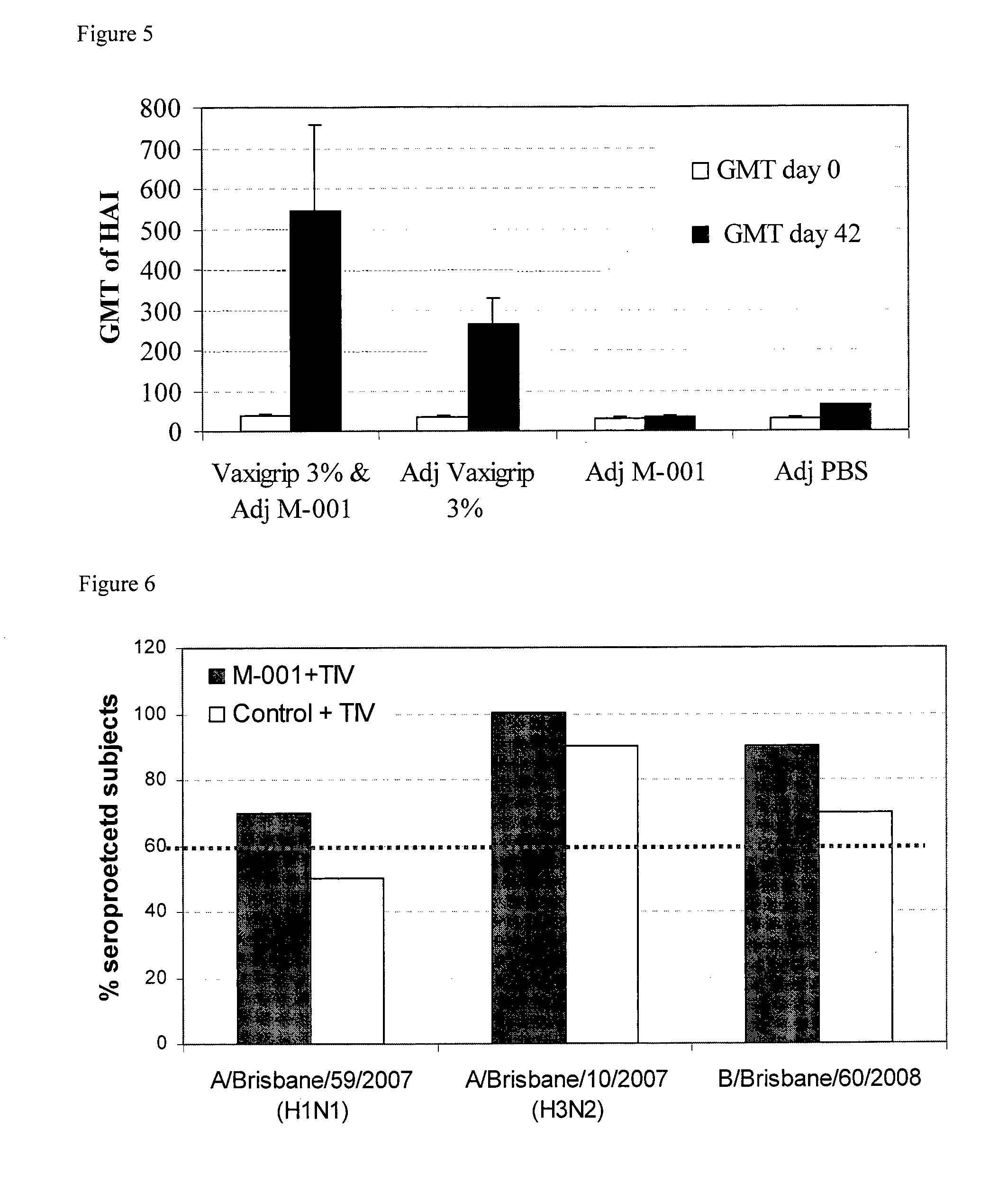Multimeric multiepitope polypeptides in improved seasonal and pandemic influenza vaccines
a multi-epitope polypeptide, influenza vaccine technology, applied in the direction of peptide sources, immunological disorders, antibody medical ingredients, etc., can solve the problems of reduced immune response of the infected individual, lethal pandemic strains, high morbidity and mortality rates, etc., to improve the protective effect of influenza vaccine, improve anti-influenza immune responses, and increase sero-protection
- Summary
- Abstract
- Description
- Claims
- Application Information
AI Technical Summary
Benefits of technology
Problems solved by technology
Method used
Image
Examples
example 1
Prime-Boost Study in Mice
[0162]The objective of this study was to determine priming effect of the M-001 vaccine in mice and the ability of the multimeric polypeptide to enhance the humoral response to a commercial trivalent vaccine.
[0163]Transgenic female HHD++2 mice 10-12 weeks old were immunized twice IM with M-001 adjuvanted 1:1 in IFA (50 μl / limb total of 100 μl / mouse). Two mice per group (showing the higher humoral immunity to M-001) were further immunized with a third immunization to follow their cellular immune responses in spleen and lymph nodes lymphocytes. Apart from these couples of mice, the rest of each group was boosted with 1.5% (0.675 mcg / 50 microliter / mouse) of an ordinary dose of Vaxigrip® for season 2009 / 2010, containing, the following three viruses: A / Brisbane / 59 / 2007 (H1N1), A / Brisbane / 10 / 2007 (H3N2), and B / Brisbane / 60 / 2008. The HAI responses to the three Brisbane strains that are included in the vaccine and also to the drifting A / New Caledonia / 20 / 99 H1N1 virus ...
example 2
Prime-Boost Study in Mice
[0165]Objective: to evaluate the M-001 vaccine potential in priming immune responses in mice by comparing humoral responses induced by immunization with M-001 vaccine followed by immunization with a commercial trivalent influenza vaccine; and to evaluate protection following immunization with the M-001 vaccine alone or with a combination of M-001 and a commercial trivalent vaccine.
[0166]Materials: Vaxigrip® for season 2005 / 2006, includes 7.5 μg of HA from each of the following strains: A / New Caledonia / 20 / 99 (H1N1), A / California / 7 / 2004 (H3N2) and B / Shanghai / 36 / 2002, in one 0.25 ml human dose. M-001: (insoluble protein), 5 mg / ml, diluted to 300 mcg / 100 microliter with PBS following sonication, and emulsified 1:1 in IFA before injection.
[0167]Method: Female HHD++2 mice 10-12 weeks old were immunized intra muscularly on days 0, 21 and 42; Volume for IM administration: Vaxigrip® (1:10 with PBS): 50 μl / limb total of 50 μl / mouse; Multimeric: total of 150 μg / 100 μl / ...
example 3
Twice Co-Administration of M-001 with Vaxigrip® in Mice
[0171]Objective: To evaluate enhancement of humoral (antibody) response (HAI) to a commercial seasonal trivalent vaccine by co-administration with M-001; to determine HAI to viruses included in the 2009 / 2010 Vaxigrip™ following co-administration with M-001 vaccine; and to determine HAI to viruses not included in the 2009 / 2010 Vaxigrip® following co-administration with M-001 vaccine.
[0172]Materials: Multimeric M-001 after microfluidizer using a microfluidizer apparatus (microfluidics, Boston, US), particle size: <8 μm, 150 μg / administration 1:1 in IFA; PBS as placebo; adjuvant: IFA included in all tested groups as 1:1 dilution. Vaxigrip® for 2009 / 2010 season (batch E7024) containing 15 mcg of HA of the following viruses: A / Brisbane / 59 / 2007 (H1N1), A / Brisbane / 10 / 2007 (H3N2), B / Brisbane / 60 / 2008. Female outbred ICR mice 10-12 weeks old (8 mice per group) were used.
[0173]Protocol: a single IM injection on day 0 and 14 according to th...
PUM
| Property | Measurement | Unit |
|---|---|---|
| sizes | aaaaa | aaaaa |
| diameter | aaaaa | aaaaa |
| pH | aaaaa | aaaaa |
Abstract
Description
Claims
Application Information
 Login to View More
Login to View More - R&D
- Intellectual Property
- Life Sciences
- Materials
- Tech Scout
- Unparalleled Data Quality
- Higher Quality Content
- 60% Fewer Hallucinations
Browse by: Latest US Patents, China's latest patents, Technical Efficacy Thesaurus, Application Domain, Technology Topic, Popular Technical Reports.
© 2025 PatSnap. All rights reserved.Legal|Privacy policy|Modern Slavery Act Transparency Statement|Sitemap|About US| Contact US: help@patsnap.com



